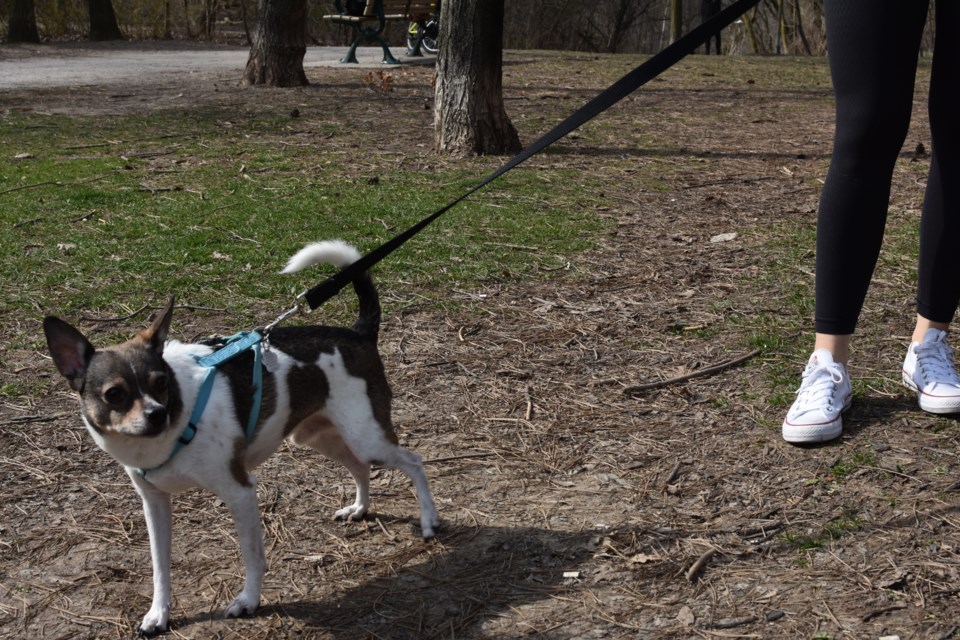Taking the dog for a walk is one of the few aspects of normal life that hasn't been entirely disrupted by the COVID-19 outbreak.
But experts have a message for all the pet owners venturing out for a puppy promenade — physical distancing rules should apply to animals too.
Veterinarians say it's possible dogs and cats could carry COVID-19 without actually having the virus themselves; their fur could be serving as a potential vehicle for transmission.
"Let's say I take my dog to a park and I let him off leash and someone pets him. Then another person pets him. When he comes back and I pet him, I've just had contact with two other people. And that's what we're trying to avoid," said Dr. Scott Weese, a veterinarian and a professor at the University of Guelph.
"We don't want animals to act as little vectors."
Public dog parks have been closing across the country for the past month as more and more provinces declared states of emergency.
But even private interactions, like letting the neighbour's kids play with your dog on your front yard, for example, are also to be avoided.
"We have to think of pets as a social extension of the family and so we really, really want to distance them," said Dr. Ian Sandler, a Toronto-based vet who sits on the national issues committee of the Canadian Veterinary Medical Association.
"That doesn't mean you can't take your dog for a walk, it just means you want to keep that separation from people and pets, just to be extra safe."
The Centers for Diseases Control and Prevention (CDC) says on its website there's no evidence "at this time" to believe COVID-19 can be transmitted through pet fur.
Kevin Coombs, an infectious disease expert at the University of Manitoba, however, said there's "nothing inherently antiseptic about hair."
"So either our hair or pet hair could conceivably carry anything for at least a little while," he said.
Though transmission of the virus from pet fur to humans might be possible in theory, Sandler expects those cases would be very uncommon.
Droplet particles from an infected individual would have to land on the pet, and someone else would have to touch the contaminated coat shortly afterwards for it to happen in the first place.
In the interest of being cautious, Sandler said infected individuals should not only self-isolate from their families, but from their pets as well to prevent spreading the virus within their homes and communities.
"We think the likelihood of this transfer is very, very low but we don't know how long the virus is active on the coats of dogs and cats," Sandler said. "If you're in self-quarantine, as horrible as it is for the two-week period or whatever it may be, you really need to be away from your pets."
The CDC website also recommends people sick with COVID-19 "limit contact with animals until more information is known about the new coronavirus."
While the virus has infected more than one million people worldwide, cases of animals testing positive for COVID-19 remain rare.
It has happened, however.
There have been instances of dogs infected in Hong Kong, and earlier this month, a tiger at the Bronx Zoo tested positive for the virus in what was believed to be the first known infection in an animal in the United States.
Sandler says the likelihood of a dog or cat becoming infected with COVID-19 is low. But if pets can get it, can they spread it that way?
"We know that these viruses can mutate, so there's always concern," said Sandler. "If they're similar in nature and they came from an animal, can they cross contaminate?
"But we think the risk of transmission, especially from a dog to a person, or to a dog from a person is rare."
Cats are "maybe still an evolving discussion," said Sandler, with the Bronx Zoo tiger serving as a good example of that. The tiger is believed to have caught the virus from a zookeeper in close contact, who also tested positive.
"Now this cat has recovered ... so its symptoms were quite mild," Sandler said. "But again, we think that for the average person living in a domesticated situation with a dog or a cat, the likelihood of this being a risk is extremely remote."
Weese agreed that pets would need to be in very close contact with the virus from a sick owner or handler — like the tiger in New York was — in order to get sick themselves.
But he said physical distancing would help limit possible transmission from those scenarios.
"If I get sick and I expose my cat and my dog, the cat stays in the house with me, the dog stays away from other people, and then there's no risk," Weese said.
"If we don't have animals exposed to a bunch of different people, we don't have to worry about whether or not they can spread it."
This report by The Canadian Press was first published April 13, 2020.
Melissa Couto, The Canadian Press


